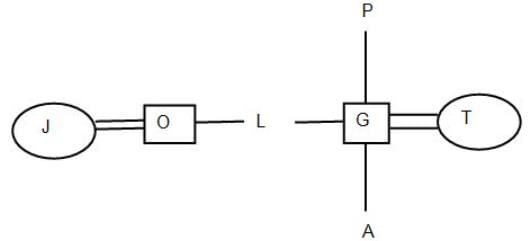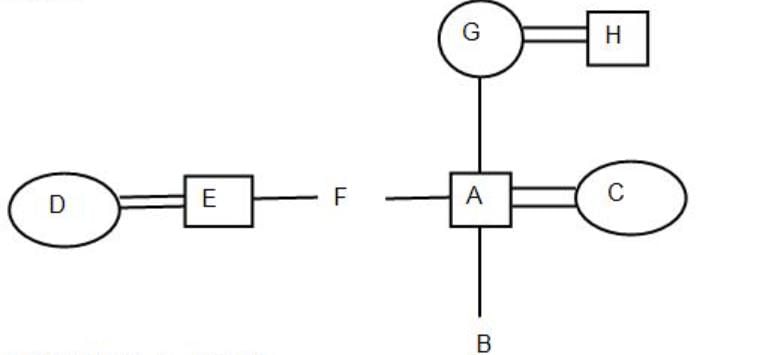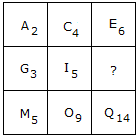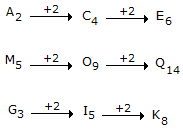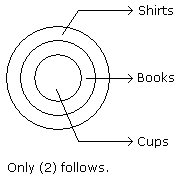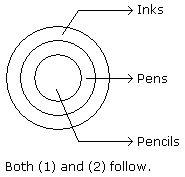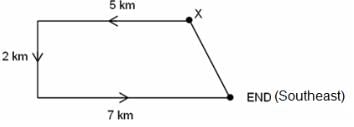Dena Bank PO Mock Test - 9 - Bank Exams MCQ
30 Questions MCQ Test - Dena Bank PO Mock Test - 9
Directions: Study the following information carefully to answer the given Questions:
P^Q-P is the child of Q
P!Q-P is the parent of Q
P*Q - P is elder to Q
P#Q-P is younger to Q
P@Q-P is brother of Q
P&Q - P is wife of Q
P+Q-P is sister-in-law of Q
Q. If G! A^T+J&O@L^P! G, then how is J related to A?
P!Q-P is the parent of Q
P*Q - P is elder to Q
P#Q-P is younger to Q
P@Q-P is brother of Q
P&Q - P is wife of Q
P+Q-P is sister-in-law of Q
Directions: Study the following information carefully to answer the given Questions:
P^Q - P is the child of Q
P!Q - P is the parent of Q
P*Q - P is elder to Q
P#Q - P is younger to Q
P@Q - P is brother of Q
P&Q - P is wife of Q
P+Q - P is sister-in-law of Q
Q. If A!B^C+D&E@F^G!A and G is the wife of H then how is G related to C?
P!Q - P is the parent of Q
P*Q - P is elder to Q
P#Q - P is younger to Q
P@Q - P is brother of Q
P&Q - P is wife of Q
P+Q - P is sister-in-law of Q
Read the passage below and solve the questions based on it.
1. In a joint family of seven persons A, B, C, D, E, F and G, there are two married couples.
2. G is a housewife and her husband is a lawyer. ‘C’ is the wife of ‘B’, ‘A’ is an engineer and is granddaughter of ‘G’. ‘D’ is the father-in-law of ‘C’, a doctor, and father of ‘E’, a Professor. ‘F’ is A’s brother and B’s son.
Who is a lawyer?
2. G is a housewife and her husband is a lawyer. ‘C’ is the wife of ‘B’, ‘A’ is an engineer and is granddaughter of ‘G’. ‘D’ is the father-in-law of ‘C’, a doctor, and father of ‘E’, a Professor. ‘F’ is A’s brother and B’s son.
Prakash, Qureshi, Rajesh and Shabdesh live together in a house.
1. Prakash lives with his (or her) parents.
2. Qureshi lives with at least 3 persons younger than him (or her).
3. Shabdeesh lives with his mother and is older than at least 2 persons living with him.
4. Rajesh lives with his (or her) son and is not older than Shabdeesh.
Q. The total number of people in that house is ______.
Prakash, Qureshi, Rajesh and Shabdesh live together in a house.
1. Prakash lives with his (or her) parents.
2. Qureshi lives with at least 3 persons younger than him (or her).
3. Shabdeesh lives with his mother and is older than at least 2 persons living with him.
4. Rajesh lives with his (or her) son and is not older than Shabdeesh.
Qureshi is Prakash’s ______.
Question:
In a certain code, 'XYZ' means 'We are friends'. Which letter stands for 'We'?
Statements:
I. 'PYN' means 'They are classmates'.
II. 'ZMS' means 'We love them'.
III. 'PX' means 'Hello friends',
Question:
Among P, Q, R, S and T, Q is the second tallest and S is immediate taller than the shortest. Who among them is in the middle when they stand in the order of their heights?
Statements:
I. T is not the shortest.
II. R is taller than S but shorter than Q.
III. P ranks third in height above S when all are arranged in the order of height.
Question: Four subjects - Physics, Chemistry, Mathematics and Biology - were taught in four consecutive periods of one hour each starting from 8.00 a.m. At what time was the Chemistry period scheduled ?
Statements:
I. Mathematics period ended at 10.00 a.m., which was preceded by Biology.
II. Physics was scheduled in the last period.
III. Mathematics period was immediately followed by Chemistry.
Question:
What is the total monthly salary of Vasu?
Statements:
I. Vasu's basic salary is Rs 100 more than Rajan's salary who also serves in Vasu's company.
II. Other allowances drawn by Rajan besides his basic salary are Rs 2000 per month which is Rs 50 less than Vasu's salary.
III. Rajan's basic salary is Rs 1550 per month,
Question:
Who is the tallest among six boys P, T, N, D, Q and R?
Statements:
I. P is taller than D and N but not-as tall as T.
II. R is taller than Q but not as tall as T.
III. Q is not taller than T and R.
40 persons are sitting in a row. How many persons are sitting between 31st person from left and 25th person from right?
In a row of 40 girls, when Komal was shifted to her left by 4 places her number from the left end of the row become 10. What was the number of Swati from the right end of the row, if Swati was three places to the right of Komal’s original position?
Directions to Solve
In each word of the following questions consists of pair of words bearing a relationship among these, from amongst the alternatives, pick up the pair that best illustrate a similar relationship.
Question -
Dawn: Sunrise
Directions to Solve
In each word of the following questions consists of pair of words bearing a relationship among these, from amongst the alternatives, pick up the pair that best illustrate a similar relationship.
Question -
Candle : Wick
Directions to Solve
In each of the following questions two statements are given and these statements are followed by two conclusions numbered (1) and (2). You have to take the given two statements to be true even if they seem to be at variance from commonly known facts. Read the conclusions and then decide which of the given conclusions logically follows from the two given statements, disregarding commonly known facts.
Give answer:
- (A) If only (1) conclusion follows
- (B) If sonly (2) conclusion follows
- (C) If either (1) or (2) follows
- (D) If neither (1) nor (2) follows and
- (E) If both (1) and (2) follow.
Question -
Statements: All the actors are girls. All the girls are beautiful.
Conclusions:
- All the actors are beautiful.
- Some girls are actors.
Directions to Solve
In each of the following questions two statements are given and these statements are followed by two conclusions numbered (1) and (2). You have to take the given two statements to be true even if they seem to be at variance from commonly known facts. Read the conclusions and then decide which of the given conclusions logically follows from the two given statements, disregarding commonly known facts.
Give answer:
- (A) If only (1) conclusion follows
- (B) If sonly (2) conclusion follows
- (C) If either (1) or (2) follows
- (D) If neither (1) nor (2) follows and
- (E) If both (1) and (2) follow.
Question -
Statements: All the windows are doors. No door is a wall.
Conclusions:
- Some windows are walls.
- No wall is a door.
Directions to Solve
In each of the following questions two statements are given and these statements are followed by two conclusions numbered (1) and (2). You have to take the given two statements to be true even if they seem to be at variance from commonly known facts. Read the conclusions and then decide which of the given conclusions logically follows from the two given statements, disregarding commonly known facts.
Give answer:
- (A) If only (1) conclusion follows
- (B) If sonly (2) conclusion follows
- (C) If either (1) or (2) follows
- (D) If neither (1) nor (2) follows and
- (E) If both (1) and (2) follow.
Question -
Statements: All cups are books. All books are shirts.
Conclusions:
- Some cups are not shirts.
- Some shirts are cups.
Directions to Solve
In each of the following questions two statements are given and these statements are followed by two conclusions numbered (1) and (2). You have to take the given two statements to be true even if they seem to be at variance from commonly known facts. Read the conclusions and then decide which of the given conclusions logically follows from the two given statements, disregarding commonly known facts.
Give answer:
- (A) If only (1) conclusion follows
- (B) If sonly (2) conclusion follows
- (C) If either (1) or (2) follows
- (D) If neither (1) nor (2) follows and
- (E) If both (1) and (2) follow.
Question -
Statements: Some cows are crows. Some crows are elephants.
Conclusions:
- Some cows are elephants.
- All crows are elephants.
Directions to Solve
In each of the following questions two statements are given and these statements are followed by two conclusions numbered (1) and (2). You have to take the given two statements to be true even if they seem to be at variance from commonly known facts. Read the conclusions and then decide which of the given conclusions logically follows from the two given statements, disregarding commonly known facts.
Give answer:
- (A) If only (1) conclusion follows
- (B) If sonly (2) conclusion follows
- (C) If either (1) or (2) follows
- (D) If neither (1) nor (2) follows and
- (E) If both (1) and (2) follow.
Question -
Statements: All the pencils are pens. All the pens are inks.
Conclusions:
- All the pencils are inks.
- Some inks are pencils.
Direction(11-15): Study the following information to answer the given questions
A$B means A is not smaller than B A@B means A is neither smaller than nor equal to B A#B means A is neither greater than nor equal to B A&B means A is neither greater than nor smaller than B A*B means A is not greater than B
Statements:
O & A, A $ R, R # S, S * Q
Conclusions:
I. Q @ R II. S @ O
III. R & O IV. R # O
A$B means A is not smaller than B A@B means A is neither smaller than nor equal to B A#B means A is neither greater than nor equal to B A&B means A is neither greater than nor smaller than B A*B means A is not greater than B
Q. Statements:
A * E, E $ F, F # O, O
@ L
Conclusions:
I. L # F
II. E @ O
III. A # O
IV. E @ L
A$B means A is not smaller than B A@B means A is neither smaller than nor equal to B A#B means A is neither greater than nor equal to B A&B means A is neither greater than nor smaller than B A*B means A is not greater than B
Q. Statements:
B @ Q, Q # A, A & L,
L * N
Conclusions:
I. N $ A
II. L @ Q
III. B @ N
IV. Q # N
A$B means A is not smaller than B A@B means A is neither smaller than nor equal to B A#B means A is neither greater than nor equal to B A&B means A is neither greater than nor smaller than B A*B means A is not greater than B
Q. Statements:
A $ E, E @ F, F * G,
G # H
Conclusions:
I. H @ E
II. A $ G
III. E @ H
IV. A @ F
In the question symbols $, #, % are used for different meanings as follows.
$ means ‘neither greater nor equal to’.
# means ‘neither greater nor smaller than’.
% means ‘neither smaller nor equal to’.
In each of the following questions, assuming the given statements to be true, find out which of the two conclusions I and II given below them is/are definitely true.
Statements: T % I, I # L, L % U
Conclusions: I. T $ L
II. U $ T
Suraj started from a point X and went 5 km westwards. He then turned left and went straight for 2 km. Again, he turned left and went straight for 7 km. In which direction was he in the end with respect to point X?




